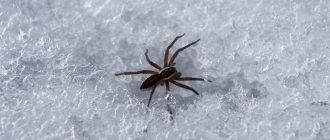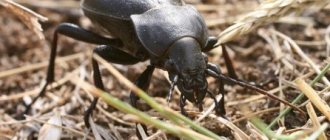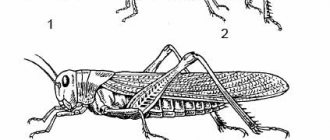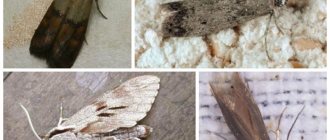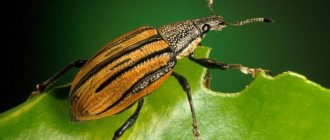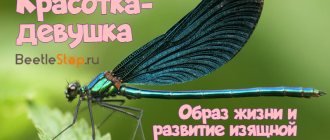Throughout their lives, insects experience a profound restructuring of the external and internal structure of the body. In other words, metamorphosis, characteristic of all animals. It’s just that it proceeds with characteristic and very specific features. Postembryonic development of an insect, as a rule, goes through three successive stages: egg, larva, imago. Many species have an additional stage: triungulin, pupa, etc.
Depending on how many stages of development an insect goes through, it can be classified into one of two large groups: with incomplete or complete transformation. Thus, the method of metamorphosis should be regarded as one of the main classification criteria.
From the article you will learn important features of the stages of insect development with complete and incomplete transformation, with hypermetamorphosis.
Imago - what is it?
The word “imago” is of Latin origin and is literally translated as “image.” In zoology, this term denotes the adult (final) stage of development of animals with a complex life cycle (insects and some arthropods). The phase is final. With its onset, the animal acquires the ability to reproduce and, as a rule, to disperse. Adults are not subject to molting. At this stage, the growth of insects and arthropods stops.
Depending on what type of metamorphosis is characteristic of each individual species, the adult stage can begin in different ways.
Independent names of some larvae
“Larva” is the common name for the second stage of insect development. However, for some families, genera, species of insects, as well as for organisms with certain developmental features, there are their own definitions. Here are some examples.
Names of larvae, depending on their development
Nymph is the larva of insects undergoing incomplete metamorphosis, as well as mites.
Triungulin is an insect larva that develops through hypermetamorphosis; The “task” of triungulins includes settlement, and after moving they transform into larvae of normal structure, which grow and develop, as befits insects at this stage.
The naiad , the larva of dragonflies and mayflies, has a special name for the reason that, unlike adults, it lives in an aquatic environment, and therefore has many distinctive features, for example, gills.
Names of larvae, depending on belonging to certain taxa
The caterpillar is the larva of Lepidoptera.
The false caterpillar is the larva of sawfly beetles.
Wireworm is the larva of click beetles.
The false wireworm is the larva of pollen eaters and darkling beetles.
Worm is the collective name for legless fly larvae.
Maggot is the larva of some flies (round stitch flies).
A rat is a larva of a hoverfly.
Coretra is the larva of some blood-sucking mosquitoes of the genus Culicidae.
Bloodworm is the larva of the bell mosquito.
The battle worm is the larva of the battle mosquito.
Development with incomplete transformation
Incomplete transformation is characterized by three stages of insect development: egg, larva and adult. A characteristic feature of this type of metamorphosis is the similarity of the appearance of the larva with the imago; like the latter, they have oral organs, compound eyes, and pronounced rudimentary wings. Moreover, a similar lifestyle is often observed. Insect larvae with incomplete metamorphosis are called nymphs.
This type of metamorphosis is observed in Orthoptera, Cockroaches, and Homoptera.
Phase variability[edit | edit code]
Phase variability of the desert locust
A special form of metamorphosis, which goes through together with the main one, is the so-called phase variability
, discovered initially in locusts, but then found in other orthoptera, as well as in stick insects, butterflies and other insects.
Its essence lies in the fact that when crowding of individuals occurs, the morphological and biological-physiological properties of the species change - the pigmentation of the integument increases (mainly due to the partial deposition of metabolic products in them), the proportions and shape of body parts change, development accelerates, and behavior changes. A gregarious phase
(lat. phasis gregaria)
arises When individuals disperse, these properties are lost and the species returns through a transition phase
(Latin phasis transiens) to its original state -
a single phase
(Latin phasis solitaria). The differences between the phases are so great that ignorance of their nature gave rise to the division of one type into 2-3.
Development with complete transformation
When fully metamorphosed, insects and arthropods go through 4 to 5 stages of development: egg, larva, pupa and adult. Sometimes the prepupal stage can be determined. The larva in this case practically does not resemble an adult shoe; to understand this, just remember the butterfly caterpillar. It lacks eyes of a complex structure and external rudiments of wings and, as a rule, has a different type of oral apparatus.
After the true larva finishes its growth, it stops feeding, becomes motionless and turns into a pupa. Then the adult hatches from it. True larvae are usually divided into three groups: caterpillars, vermiforms (beetles, dipterans, etc.), campodeoids (ground beetles, diving beetles, etc.).
This type of metamorphosis is characteristic of all Lepidoptera (butterflies), Coleoptera, and Diptera.
PURPOSE AND CHARACTERISTICS OF DEVELOPMENT PHASES
INSECT DEVELOPMENT
During their individual development, or ontogenesis, insects go through two periods - embryonic, i.e. development inside the egg, and postembryonic, or development after leaving the egg. In general, development in insects is accompanied by the passage of three or four phases: egg, larva, pupa and adult or imago. After leaving the egg, in the postembryonic period, the development of insects proceeds with the transformation of one phase into another. This type of ontogenesis is called metamorphosis. The essence of metamorphosis is that a developing individual undergoes a significant restructuring of its morphological organization and biological characteristics during its life.
In accordance with the total number of development phases, two main types of transformation are distinguished - incomplete and complete (Fig. 1, 2).
Rice. 1. Migratory locust (incomplete transformation): 1 – egg capsule, 2–6 – larvae of 1st–5th instars; 7 – adult insect.
Incomplete transformation or hemimetamorphosis - characterized by the passage of three phases: eggs, larvae, imago. The larvae are externally similar to the adult phase, as they have:
1) complex compound eyes like in adults;
2) the same oral organs;
3) the same body shape, older larvae have the rudiments of wings and are called exotergotes;
4) lead a similar lifestyle to adult individuals and can be found together. Due to their similarity, the larvae are called imago-like; their body is clearly divided into a thorax and abdomen.
Rice. 2. Apple flower beetle (complete transformation): 1 – egg; 2 – larva; 3 – pupa; 4 – adult insect.
The difference between an imago-like larva and an adult individual lies in the different number of segments in the legs and antennae, as well as in the undeveloped reproductive system.
Complete transformation or holometamorphosis is characterized by the passage of four phases - eggs, larvae, pupae, imago. The larvae are not similar to the adult, so they are called non-imaginous or secondary. The larvae have:
1) another type of oral apparatus;
2) a different body shape, they lack wing rudiments and these larvae are called endotergotes;
3) the larvae lack complex compound eyes; they have simple lens-type eyes;
4) larvae live in different environmental conditions than adults.
Therefore, most of the organs of non-imaginous larvae are temporary, provisional in nature, performing the functions of larval life. Nothing remains of these organs in the adult insect. Temporary organs of insect larvae with complete transformation include: abdominal legs, mouthparts, silk-secreting or arachnoid glands.
Incomplete and complete transformation are the two main types of insect metamorphosis, but do not exhaust all its diversity. Modifications of incomplete transformation are hypomorphosis and hypermorphosis, and modifications of complete transformation are hypermetamorphosis.
Hypomorphosis is a simplified incomplete transformation. Characteristic of those insects that, in the process of evolution, have lost their wings and are secondary wingless. These are lice, cockroaches, grasshoppers, bedbugs. Due to the absence of wings, adults and larvae, i.e. nymphs are very similar to each other. Differences in larvae are manifested in smaller body sizes and less noticeable details of morphology - a smaller number of segments in the antennae and tarsus, body coloration, structure and segmentation of the cerci, etc. The lifestyle of adult individuals and hypomorphic larvae are similar.
Hypermorphosis is a complicated incomplete transformation. The peculiarity is that at the end of the larval phase, a resting larval phase appears, which is called a nymph, or false pupa. This is a motionless, older larva that has the rudiments of wings and looks like an adult insect.
Hypermorphosis is characteristic of aleurodids, thrips and male coccids.
| Rice. 3. Hypermetamorphosis of the blister beetle – Epicauta: 1 – adult insect; 2 – campodeoid larva (1st instar); 3–5 – subsequent worm-like larvae; 6 – prepupa; 7 – pupa. |
Hypermetamorphosis is a complicated (excessive) complete transformation. Its characteristic feature is the presence of several forms of larvae, and sometimes pupae, in the development cycle. In Hymenoptera parasites, the larva of the 1st instar is caudate or vesicular, and from the 2nd instar it is legless. Coleopteran predators are also characterized by 2 types of larvae: campodeoid and legless; the true larva is transitional between them (Fig. 3). Excessive complete transformation is characteristic of beetles from the blister family, and is also observed in parasitic dipterans from the buzzer family.
INSECTS
In general, an insect egg is a large cell and, in addition to the nucleus, contains a yolk, which is necessary for the nutrition and development of the embryo (Fig. 4). The outside of the egg is covered with chorion - a membrane formed due to secretions of the follicular epithelium.
Rice. 4. Egg and its types: 1 – structure of a fly egg; 2 – locust egg; 3 – section of the chorion of a locust egg at high magnification; 4 – psyllid egg; 5 – bug; 6 – white butterflies; 7 – cutworm butterflies; 8 – leaf beetle; 9 – cabbage fly: a – micropyle; b – chorion; c – vitelline membrane; g – core; d – yolk; e – polar bodies.
Embryonic development begins with fragmentation of the nucleus (Fig. 5) and the movement of the resulting daughter nuclei with small areas of protoplasm to the periphery of the egg. Here, from the mass of daughter nuclei, a continuous layer of cells is formed - the blastoderm. Subsequently, it differentiates into embryonic and extra-embryonic zones. The cells of the germinal zone begin to divide more intensively and form a germ band on the ventral side.
| Rice. 5. Crushing the egg of a leaf beetle. A – at the beginning of crushing; B – at the end of crushing: 1 – yolk balls; 2 – cells arising from the fragmenting nucleus; 3 – plasma; 4 – blastoderm; 5 – germ cells. |
The development of the embryo is accompanied by blastokinesis, the formation of embryonic membranes and segmentation (Fig. 6). Blastokinesis is the movement of the embryo to new, not yet assimilated areas of the yolk in the egg. It occurs almost simultaneously with the formation of the embryonic membranes.
On the surface of the chorion there is a micropyle - an opening that serves for the passage of sperm during fertilization.
The shape of eggs can be oval or elongated oval, cylindrical, spherical, hemispherical, barrel-shaped, pear-shaped, bottle-shaped, etc. Some groups of insects have an elongated stalk at one of the poles, with the help of which the egg is attached to the substrate.
Rice. 6. Methods of formation of embryonic membranes and blastokinesis in insects. A – embryo before the formation of membranes; B – initial stage of their formation; B – completion of the formation of embryonic membranes. The top row is ancient-winged and hemipteroid insects, the bottom row is orthopteroid and with complete transformation: 1 – head section of the embryo, 2 – amnion, 3 – serosa.
The length of eggs varies within a very wide range - from 0.01–0.02 mm to 8–12 mm.
The sculpture of the surface of the egg is very diverse: it can be smooth, covered with tubercles, wrinkles or grooves, and also have longitudinal or transverse ribs, and sometimes both. In the latter case, the surface of the egg is called reticular. In some eggs, at high magnification of the microscope, a micropylar zone is visible, located in most eggs on the upper pole, less often on the lateral surface. The micropylar zone usually has a more complex sculpture than the rest of the chorion.
The color of the outer layer of the chorion is most often one-color, glassy-transparent, with a greenish or yellowish tint, or white, yellow, orange, red and black. Sometimes against the general background there is a multi-colored color in the form of spots, stripes, colored rings. Using color as one of the diagnostic signs, one should take into account its change as the embryo develops and before the hatching of the larva, as well as when the embryo dies due to colonization by a parasite or disease. Thus, newly laid turtle bug eggs have a uniform light green color with white dots around the lid; on the 2nd–3rd day of embryo development, the eggs darken and acquire a brownish tint; on the 3rd–4th day, the light green color is restored and a rounded dark spot appears on the lid; Before the larva emerges, the egg shell takes on a pinkish tint. The eggs of the turtle bug, infested with oviparous insects, acquire a black and bluish-black color.
For an accurate diagnosis of eggs, despite the variety of the listed signs, they are often not enough, and therefore it is also necessary to take into account the nature of laying: the method and shape, the position of the eggs in relation to the substrate.
According to the method of laying, eggs are distinguished: openly laid on the surface of the substrate; completely or partially hidden in the substrate; protected by the shell of a leathery capsule, hairs from the abdomen of the female; covered with a shield of secretions from the female's accessory glands.
The pattern of egg laying is also varied. Females lay eggs singly or in small groups of 3–5 eggs, or in large piles of several hundred eggs, placed in more or less regular rows in one, two, three layers, or laid randomly (Fig. 7).
In most cases, the development of an insect in the egg phase does not last long - from several days to 2-3 weeks. If wintering takes place in the egg phase, the embryonic period extends for 6–9 months.
A fully formed embryo fills the entire egg, is often characterized by darkening of the eyes and mouthparts, and is ready to hatch. This is already a larva that begins to move, swallows amneotic fluid and thereby increases the size of its body. The larva comes out and hatches. At the same time, she gnaws through the shell of the egg - the chorion, cuts or drills it with a special organ - a saw-shaped formation on the head, a thorn, etc.
| Rice. 7. Clutches of eggs of various insects: 1 – Hessian fly; 2 – yellow gooseberry sawfly; 3 – beet fly; 4 – cherry social sawfly; 5 – lacewings (hatching larva on the left); 6 – potato ladybird; 7 – Colorado potato beetle; 8 – migratory locust (sectional egg capsule); 9 – shield carriers. |
The larval phase begins after hatching from the egg. The main function of this phase is the growth and nutrition of the larva. Immediately after hatching, the larva is usually colorless or whitish and has soft skin. In openly living larvae, coloring and hardening of the integument occurs quickly and the larvae acquire their natural appearance. The larva enters a time of increased nutrition, growth and development. Growth and development is accompanied by periodic molting - shedding of the skin cuticle; Thanks to molting, the body increases and its external changes occur.
The number of molts during the development of the larva is not the same and in different insects it varies from 3 (diptera) or 4–5 (straight and lepidoptera) to 25–30 in mayflies. After each molt, the larva enters the next stage or instar. In insects with incomplete metamorphosis, larvae of different ages differ in a number of characteristics - the degree of development of wing primordia, the number of segments in the antennae and legs.
In insect larvae with complete metamorphosis, the transition from one instar to another is manifested in an increase in body size.
The following types of non-imaginous larvae are distinguished: according to N.N. Bogdanov-Katkov – 5 types; according to G.Ya. Bey-Bienko – 3 types (Fig. 8).
I. Vermiformes:
1) headless (the head and legs are not expressed) - the larvae of most flies (order Diptera);
Rice. 8. Types of insect larvae with complete metamorphosis.
Vermiform: 1 – headless; 2 – legless; 3 – true larva; caterpillars: 4 – caterpillar; 5 – false caterpillar; 6, 7 – campodeoid.
2) legless (the head is separate, the legs are not expressed) - larvae of weevils (order Coleoptera), stem sawflies, bees, ants (order Hymenoptera);
3) true larva (with a head and true, i.e., pectoral, legs) - in most beetles (order Coleoptera). They are called true legs because they are articulated and consist of the same parts as those of an adult insect. Like imagoes, there are always three pairs of them.
II. Caterpillars (have false legs, which are unsegmented paired outgrowths of the skin (not preserved in the imago) and are located on the abdominal part of the larvae’s body (they are also called abdominal legs)):
4) caterpillar (with a separate head, thoracic legs and two to five pairs of abdominal legs) – butterfly larvae (order Lepidoptera);
5) false caterpillar (with a pronounced head, thoracic legs and six to eight pairs of abdominal legs) - the larvae of true sawflies from the order Hymenoptera.
III. Campodeoid (the head is well developed with the mouth parts directed forward, the upper jaws are powerful and pointed towards the apex, the pectoral legs are long and twice the width of the chest, the tergites are dense, especially the pectoral parts, the last segment of the abdomen is often with paired appendages, the antennae are well developed). These are predator larvae (ground beetles, coccinellids - coleopterans, lacewings - lacewings).
Having finished growing, the last instar larva stops feeding, becomes motionless, molts for the last time and turns into a pupa.
The pupal phase is characteristic only of insects with complete metamorphosis. The pupa remains in a motionless state, is unable to feed and lives off the reserves accumulated by the larva. In the pupal phase, intensive processes of internal restructuring of the larval organization into the imaginal one occur. Externally, the pupa does not resemble the imago, but has a number of signs of the adult phase - external rudiments of wings, legs, antennae, compound eyes. Before pupation, the larva surrounds itself with a cocoon. Pupation occurs inside the cocoon and the pupa is protected from external conditions. The cocoon is characteristic of butterfly caterpillars, sawfly larvae, wasps, etc.
| Rice. 9. Types of pupae: 1 – open; 2 – covered; 3 – hidden. |
The pupae of different insects differ significantly from each other in structural features. There are 3 main types of pupae (Fig. 9):
1) free, or open - have appendages of the future adult insect that are freely separated from the body - antennae, legs, wings, dimly colored, without a pattern, with soft covers. Such pupae are found in most representatives of the orders Coleoptera (beetles), Hymenoptera (bees, wasps, sawflies, wasps), as well as in some flies;
2) covered - have noticeable imaginal appendages - antennae, legs, wings, which, together with the body, are covered with a hard shell of secretions of the larval glands and cannot be separated from the body. Characteristic of Lepidoptera (butterflies) and some beetles, for example, coccinellids;
3) barrel-shaped, or hidden, - have an unshed larval skin, in which there is a free pupa of a headless larva. This type of pupa is called a false cocoon, or puparia. It has hard covers with transverse segmentation, color from light yellow to dark brown. The type is characteristic of higher dipterans (flies).
True cocoons, which serve as shelters for free or covered pupae, are made by the larvae after finishing feeding from the secretions of silk-secreting glands (mulberry, oak silkworms, cabbage and apple moths) or salivary glands that bind the soil (for example, true sawflies), or from food bits and excrement. Many larvae of beetles and butterflies pupate in the soil, where they make a cradle, earthen cells, the walls of which are strengthened in various ways. Sometimes plant stems and rolled leaves serve as shelters for pupae.
In the pupal phase, non-imaginous larvae undergo a restructuring of the entire morphophysiological and biological organization of the insect. It covers two mutual processes - histolysis and histogenesis.
The essence of histolysis is the disintegration of internal larval organs. This process is accompanied by the penetration and implementation of red blood cells - hemocytes - into the tissue. The source for their formation are histolysis products dissolved in the hemolymph.
Histolysis is replaced by the process of creating new tissues and organs of imaginal life - histogenesis.
As a result of these two interrelated processes, the imago phase arises. With incomplete transformation in larvae, internal changes occur gradually and, upon transition to the adult phase, are not accompanied by restructuring of the larval body, i.e. many organs of the larva (eyes, antennae, legs) are retained by the imago.
The imago phase begins after the pupa sheds its skin. The insect spreads its wings, its outer coverings thicken and become colored. In this phase, insects cannot grow. The main function of an adult insect is reproduction and dispersal. This is a function of species life and is aimed at maintaining the existing species.
The adult phase is characterized by the following features:
1) sexual dimorphism;
2) polymorphism;
| Rice. 10. Sexual dimorphism. A – swimming beetle; B – stag beetle; B – rhinoceros beetle (left – male, right – female). |
3) additional food;
4) fertility.
Sexual dimorphism is the differences between females and males, manifested in a number of external secondary sexual characteristics and behavioral characteristics (Fig. 10).
Sexual dimorphism is manifested by a number of characteristics:
– females are larger than males;
– males are distinguished by stronger development of their antennae (the subfamily of beetles from the family of lamellar beetles, butterflies from the family of silkworms, the family of moths);
– males differ in the color of the body and wings, as well as greater mobility;
– females may be deprived of wings and legs (scale insect family);
– males may have a characteristic horn-like growth on their head;
– difference in lifestyle and behavior, i.e. males are capable of chirping (order Orthoptera).
Polymorphism is the existence of adults in three or more forms. These forms are adapted to perform their special functions in the population of a given species (Fig. 11).
Polymorphism is characteristic of socially living insects - ants, bees, wasps. These insects are characterized by differentiation of individuals in the family into several forms: males, females, workers, soldiers. Workers are immature females. Soldiers are working individuals with highly developed mouthparts that play an important role in protecting the nest from enemies. This sexual polymorphism occurs as a result of special telergones secreted by the uterus, which affect working individuals, which slows down the development of their gonads and affects their behavior.
Rice. 11. Sexual polymorphism in the Turkestan termite: 1 – winged individual; 2 – sexually mature individual; 3 – male who has shed his wings; 4 – worker; 5 – soldier.
Environmental polymorphism can occur under the influence of the external environment. Insects often have varying degrees of wing development. Insect species are characterized not only by differences in the degree of development of wings in males and females, but also by the fact that representatives of one or both sexes can have several forms - long-winged, short-winged and wingless (order Orthoptera, Fringed-winged, Hemiptera) (Fig. 12).
Rice. 12. Polymorphism in the pine underbark bug: 1 – male; 2 – long-winged female; 3 – short-winged female.
Additional food. Some species, at the onset of the imaginal phase, have mature sexual production, are capable of mating and egg-laying, without needing nutrition (the families of cocoon moths, silkworms, and moths). They have underdeveloped mouth parts and are unable to eat. Their life is limited to a few days, and sometimes even hours. After laying eggs, these insects die.
In most cases, insects immediately after transition to the adult phase have underdeveloped gonads, i.e. are immature and require additional nutrition for normal reproduction. The nutrition of adult insects, necessary for the maturation of sexual production, is called additional. The period of additional feeding can be of varying duration - depending on the type of insect, living conditions of the adult phase, and sometimes the larvae. Therefore, the sexually mature state can occur in 5–10 days, or maybe in a month or more.
Additional nutrition is typical for individuals overwintering as adults, since during wintering the reserves of the fat body are consumed. In spring, they especially need additional nutrition, which manifests itself in the great harmfulness of herbivorous species. Additional nutrition of the adult is not the main one, since during the development of the larva the nutritional function belongs to it.
Fertility. The fertility of insects is a constant value. It is determined by two factors:
Ø hereditary properties of the species (structure and size of the ovaries), i.e. its reproductive potential. This fertility is called potential;
Ø environmental factors. This fertility is called actual.
Under optimal conditions, actual fertility approaches potential fertility. A decrease in potential fertility occurs under the influence of unfavorable environmental conditions - temperature, humidity, nutritional conditions.
The potential fertility of the winter cutworm is 1200–1800 eggs, the meadow moth is up to 800 eggs; bread sawflies - up to 50 eggs; Colorado potato beetle – 2400–3600 eggs.
INSECT DEVELOPMENT
During their individual development, or ontogenesis, insects go through two periods - embryonic, i.e. development inside the egg, and postembryonic, or development after leaving the egg. In general, development in insects is accompanied by the passage of three or four phases: egg, larva, pupa and adult or imago. After leaving the egg, in the postembryonic period, the development of insects proceeds with the transformation of one phase into another. This type of ontogenesis is called metamorphosis. The essence of metamorphosis is that a developing individual undergoes a significant restructuring of its morphological organization and biological characteristics during its life.
In accordance with the total number of development phases, two main types of transformation are distinguished - incomplete and complete (Fig. 1, 2).
Rice. 1. Migratory locust (incomplete transformation): 1 – egg capsule, 2–6 – larvae of 1st–5th instars; 7 – adult insect.
Incomplete transformation or hemimetamorphosis - characterized by the passage of three phases: eggs, larvae, imago. The larvae are externally similar to the adult phase, as they have:
1) complex compound eyes like in adults;
2) the same oral organs;
3) the same body shape, older larvae have the rudiments of wings and are called exotergotes;
4) lead a similar lifestyle to adult individuals and can be found together. Due to their similarity, the larvae are called imago-like; their body is clearly divided into a thorax and abdomen.
Rice. 2. Apple flower beetle (complete transformation): 1 – egg; 2 – larva; 3 – pupa; 4 – adult insect.
The difference between an imago-like larva and an adult individual lies in the different number of segments in the legs and antennae, as well as in the undeveloped reproductive system.
Complete transformation or holometamorphosis is characterized by the passage of four phases - eggs, larvae, pupae, imago. The larvae are not similar to the adult, so they are called non-imaginous or secondary. The larvae have:
1) another type of oral apparatus;
2) a different body shape, they lack wing rudiments and these larvae are called endotergotes;
3) the larvae lack complex compound eyes; they have simple lens-type eyes;
4) larvae live in different environmental conditions than adults.
Therefore, most of the organs of non-imaginous larvae are temporary, provisional in nature, performing the functions of larval life. Nothing remains of these organs in the adult insect. Temporary organs of insect larvae with complete transformation include: abdominal legs, mouthparts, silk-secreting or arachnoid glands.
Incomplete and complete transformation are the two main types of insect metamorphosis, but do not exhaust all its diversity. Modifications of incomplete transformation are hypomorphosis and hypermorphosis, and modifications of complete transformation are hypermetamorphosis.
Hypomorphosis is a simplified incomplete transformation. Characteristic of those insects that, in the process of evolution, have lost their wings and are secondary wingless. These are lice, cockroaches, grasshoppers, bedbugs. Due to the absence of wings, adults and larvae, i.e. nymphs are very similar to each other. Differences in larvae are manifested in smaller body sizes and less noticeable details of morphology - a smaller number of segments in the antennae and tarsus, body coloration, structure and segmentation of the cerci, etc. The lifestyle of adult individuals and hypomorphic larvae are similar.
Hypermorphosis is a complicated incomplete transformation. The peculiarity is that at the end of the larval phase, a resting larval phase appears, which is called a nymph, or false pupa. This is a motionless, older larva that has the rudiments of wings and looks like an adult insect.
Hypermorphosis is characteristic of aleurodids, thrips and male coccids.
| Rice. 3. Hypermetamorphosis of the blister beetle – Epicauta: 1 – adult insect; 2 – campodeoid larva (1st instar); 3–5 – subsequent worm-like larvae; 6 – prepupa; 7 – pupa. |
Hypermetamorphosis is a complicated (excessive) complete transformation. Its characteristic feature is the presence of several forms of larvae, and sometimes pupae, in the development cycle. In Hymenoptera parasites, the larva of the 1st instar is caudate or vesicular, and from the 2nd instar it is legless. Coleopteran predators are also characterized by 2 types of larvae: campodeoid and legless; the true larva is transitional between them (Fig. 3). Excessive complete transformation is characteristic of beetles from the blister family, and is also observed in parasitic dipterans from the buzzer family.
PURPOSE AND CHARACTERISTICS OF DEVELOPMENT PHASES
INSECTS
In general, an insect egg is a large cell and, in addition to the nucleus, contains a yolk, which is necessary for the nutrition and development of the embryo (Fig. 4). The outside of the egg is covered with chorion - a membrane formed due to secretions of the follicular epithelium.
Rice. 4. Egg and its types: 1 – structure of a fly egg; 2 – locust egg; 3 – section of the chorion of a locust egg at high magnification; 4 – psyllid egg; 5 – bug; 6 – white butterflies; 7 – cutworm butterflies; 8 – leaf beetle; 9 – cabbage fly: a – micropyle; b – chorion; c – vitelline membrane; g – core; d – yolk; e – polar bodies.
Embryonic development begins with fragmentation of the nucleus (Fig. 5) and the movement of the resulting daughter nuclei with small areas of protoplasm to the periphery of the egg. Here, from the mass of daughter nuclei, a continuous layer of cells is formed - the blastoderm. Subsequently, it differentiates into embryonic and extra-embryonic zones. The cells of the germinal zone begin to divide more intensively and form a germ band on the ventral side.
| Rice. 5. Crushing the egg of a leaf beetle. A – at the beginning of crushing; B – at the end of crushing: 1 – yolk balls; 2 – cells arising from the fragmenting nucleus; 3 – plasma; 4 – blastoderm; 5 – germ cells. |
The development of the embryo is accompanied by blastokinesis, the formation of embryonic membranes and segmentation (Fig. 6). Blastokinesis is the movement of the embryo to new, not yet assimilated areas of the yolk in the egg. It occurs almost simultaneously with the formation of the embryonic membranes.
On the surface of the chorion there is a micropyle - an opening that serves for the passage of sperm during fertilization.
The shape of eggs can be oval or elongated oval, cylindrical, spherical, hemispherical, barrel-shaped, pear-shaped, bottle-shaped, etc. Some groups of insects have an elongated stalk at one of the poles, with the help of which the egg is attached to the substrate.
Rice. 6. Methods of formation of embryonic membranes and blastokinesis in insects. A – embryo before the formation of membranes; B – initial stage of their formation; B – completion of the formation of embryonic membranes. The top row is ancient-winged and hemipteroid insects, the bottom row is orthopteroid and with complete transformation: 1 – head section of the embryo, 2 – amnion, 3 – serosa.
The length of eggs varies within a very wide range - from 0.01–0.02 mm to 8–12 mm.
The sculpture of the surface of the egg is very diverse: it can be smooth, covered with tubercles, wrinkles or grooves, and also have longitudinal or transverse ribs, and sometimes both. In the latter case, the surface of the egg is called reticular. In some eggs, at high magnification of the microscope, a micropylar zone is visible, located in most eggs on the upper pole, less often on the lateral surface. The micropylar zone usually has a more complex sculpture than the rest of the chorion.
The color of the outer layer of the chorion is most often one-color, glassy-transparent, with a greenish or yellowish tint, or white, yellow, orange, red and black. Sometimes against the general background there is a multi-colored color in the form of spots, stripes, colored rings. Using color as one of the diagnostic signs, one should take into account its change as the embryo develops and before the hatching of the larva, as well as when the embryo dies due to colonization by a parasite or disease. Thus, newly laid turtle bug eggs have a uniform light green color with white dots around the lid; on the 2nd–3rd day of embryo development, the eggs darken and acquire a brownish tint; on the 3rd–4th day, the light green color is restored and a rounded dark spot appears on the lid; Before the larva emerges, the egg shell takes on a pinkish tint. The eggs of the turtle bug, infested with oviparous insects, acquire a black and bluish-black color.
For an accurate diagnosis of eggs, despite the variety of the listed signs, they are often not enough, and therefore it is also necessary to take into account the nature of laying: the method and shape, the position of the eggs in relation to the substrate.
According to the method of laying, eggs are distinguished: openly laid on the surface of the substrate; completely or partially hidden in the substrate; protected by the shell of a leathery capsule, hairs from the abdomen of the female; covered with a shield of secretions from the female's accessory glands.
The pattern of egg laying is also varied. Females lay eggs singly or in small groups of 3–5 eggs, or in large piles of several hundred eggs, placed in more or less regular rows in one, two, three layers, or laid randomly (Fig. 7).
In most cases, the development of an insect in the egg phase does not last long - from several days to 2-3 weeks. If wintering takes place in the egg phase, the embryonic period extends for 6–9 months.
A fully formed embryo fills the entire egg, is often characterized by darkening of the eyes and mouthparts, and is ready to hatch. This is already a larva that begins to move, swallows amneotic fluid and thereby increases the size of its body. The larva comes out and hatches. At the same time, she gnaws through the shell of the egg - the chorion, cuts or drills it with a special organ - a saw-shaped formation on the head, a thorn, etc.
| Rice. 7. Clutches of eggs of various insects: 1 – Hessian fly; 2 – yellow gooseberry sawfly; 3 – beet fly; 4 – cherry social sawfly; 5 – lacewings (hatching larva on the left); 6 – potato ladybird; 7 – Colorado potato beetle; 8 – migratory locust (sectional egg capsule); 9 – shield carriers. |
The larval phase begins after hatching from the egg. The main function of this phase is the growth and nutrition of the larva. Immediately after hatching, the larva is usually colorless or whitish and has soft skin. In openly living larvae, coloring and hardening of the integument occurs quickly and the larvae acquire their natural appearance. The larva enters a time of increased nutrition, growth and development. Growth and development is accompanied by periodic molting - shedding of the skin cuticle; Thanks to molting, the body increases and its external changes occur.
The number of molts during the development of the larva is not the same and in different insects it varies from 3 (diptera) or 4–5 (straight and lepidoptera) to 25–30 in mayflies. After each molt, the larva enters the next stage or instar. In insects with incomplete metamorphosis, larvae of different ages differ in a number of characteristics - the degree of development of wing primordia, the number of segments in the antennae and legs.
In insect larvae with complete metamorphosis, the transition from one instar to another is manifested in an increase in body size.
The following types of non-imaginous larvae are distinguished: according to N.N. Bogdanov-Katkov – 5 types; according to G.Ya. Bey-Bienko – 3 types (Fig. 8).
I. Vermiformes:
1) headless (the head and legs are not expressed) - the larvae of most flies (order Diptera);
Rice. 8. Types of insect larvae with complete metamorphosis.
Vermiform: 1 – headless; 2 – legless; 3 – true larva; caterpillars: 4 – caterpillar; 5 – false caterpillar; 6, 7 – campodeoid.
2) legless (the head is separate, the legs are not expressed) - larvae of weevils (order Coleoptera), stem sawflies, bees, ants (order Hymenoptera);
3) true larva (with a head and true, i.e., pectoral, legs) - in most beetles (order Coleoptera). They are called true legs because they are articulated and consist of the same parts as those of an adult insect. Like imagoes, there are always three pairs of them.
II. Caterpillars (have false legs, which are unsegmented paired outgrowths of the skin (not preserved in the imago) and are located on the abdominal part of the larvae’s body (they are also called abdominal legs)):
4) caterpillar (with a separate head, thoracic legs and two to five pairs of abdominal legs) – butterfly larvae (order Lepidoptera);
5) false caterpillar (with a pronounced head, thoracic legs and six to eight pairs of abdominal legs) - the larvae of true sawflies from the order Hymenoptera.
III. Campodeoid (the head is well developed with the mouth parts directed forward, the upper jaws are powerful and pointed towards the apex, the pectoral legs are long and twice the width of the chest, the tergites are dense, especially the pectoral parts, the last segment of the abdomen is often with paired appendages, the antennae are well developed). These are predator larvae (ground beetles, coccinellids - coleopterans, lacewings - lacewings).
Having finished growing, the last instar larva
Development with hypermetamorphosis
The most difficult way for insects to develop is hypermetamorphosis. It is characteristic of some beetles (micromalthus, blister beetles, etc.), lacewings, buzz flies, and a number of hymenoptera.
During hypermetamorphosis, the larval stage of insect development occurs in several stages. There are strong differences in the structure and lifestyle of larvae of different ages. At the first stage, they do not feed, but at the same time they actively move and settle. The older larva, as a rule, lives in a specific habitat. She not only eats, but also grows. Sometimes, in order to move from one active form to another, a restructuring of the body is required. In these cases, the larva becomes motionless and stops feeding. A so-called “false pupa” is formed. Later, as, for example, in beetles from the Blister family, it turns into a real pupa, from which the beetle imago develops.
Seasonal cycle and seasonal polymorphism of insects
The total duration of insect development, as well as the duration of existence of individual stages, varies greatly. In some species, the entire development cycle fits into one year, while in others the development proceeds much faster, and several generations manage to change within a year. Finally, there are forms whose life cycle takes several years (up to 17 years for one American cicada).
In insects, there is a fairly strict association of certain stages of development with a specific season of the year - a phenomenon called the seasonal cycle. An important role in this regard is played by the widespread phenomenon of diapause in insects: a state of deep physiological rest, accompanied by retardation of growth and development. Diapause, which arose as an adaptation to surviving unfavorable conditions, manifests itself in many species at different phases of the cycle: from egg to adult inclusive. The vitality of an organism in a state of diapause increases noticeably.
The transition of insects from an active state to a dormant state is controlled by a complex neurohumoral mechanism. Neurosecretory cells control the functioning of the endocrine glands, which produce hormones, which, in turn, inhibit or activate development processes. The signal for the activation of these mechanisms is provided by environmental factors, with the length of daylight hours (photoperiod) playing the most important role. Temperature, humidity, changes in the chemical composition of food are changeable and unstable factors. Photoperiod is a constant value for every day of the year. Reducing the length of daylight hours, regardless of specific weather conditions, seems to warn insects about the approach of unfavorable conditions. Diapause occurs, as a rule, during a period when, it would seem, the further active existence of the organism is still quite possible. However, such an early break in development is biologically quite justified, since at the end of the season there may not be enough time to complete the cycle completely. The confinement of diapause in each specific species to a specific phase—egg, larva, pupa, or adult—leads to the fact that diapausing individuals find themselves in a similar physiological state by the beginning of winter. There seems to be a gradual accumulation of a homogeneous and low-temperature-resistant stock of wintering individuals.
Environmental factors (temperature, humidity, etc.) also serve as a signal to exit the diapause state. When favorable conditions occur, the development of insects resumes. Thus, diapause is an important regulatory and synchronizing mechanism that determines the course of the seasonal cycle of each specific insect species.
Literature: A. Dogel. Zoology of invertebrates. Edition 7, revised and expanded. Moscow "Higher School", 1981
Features of the structure of the imago
As mentioned above, the final stage of development of insects and some arthropods is the adult. What it is is easy to understand by referring to the original language. In some sources the term is translated as “true appearance” and this is true. Throughout their lives at this stage, adult individuals practically do not change; their development process stops. Most species do not molt. However, all rules have exceptions. Thus, lower orders (bristletails, springtails, etc.) periodically shed their cuticle even in the adult stage.
The main differences between adult insects and young individuals are as follows. They develop wings and genitals, antennae consist of a constant number of segments, and a certain type of oral apparatus is formed (often different from that of the larvae). The imago is maximally adapted to the environment, and this is expressed in adaptive mechanisms and many structural features: features of the respiratory system, body shape, development of sensory organs, additional protective mechanisms, etc.
For the vast majority of arthropods and insects, this phase is the peak of development. The only exceptions are some mites. For them, everything happens exactly the opposite. Parasitic species moving inside the body cavities and tissues of the host lose the morphological features inherent in the imago. This process is called dismaginization.
The meaning of insects
Insects play a very important role both in nature and in human life.
Dung beetles that live in the soil are able to improve its structure by enriching it with humus. Ants, ladybugs, wasps and other insects are capable of destroying a large number of agricultural pests.
People use honey bees very successfully in their economic activities. Bees collect flower nectar and at the same time pollinate plants.
Hymenoptera insects: bees, ants, termites and some wasps live in families, forming entire colonies. Such insects are called social.
Bees are representatives of social insects
In the colonies one can distinguish: females and queens, males, soldiers, scouts, nannies, working individuals, etc.
Man has adapted to breeding silkworms, from whose cocoon threads natural silk is made.
Silkworm
Some representatives of insects are capable of very quickly destroying the trunks of dead trees, animal corpses, manure, etc. This helps to fulfill a sanitary role and maintain the circulation of substances in nature.
In some countries, insects (such as locusts) are eaten
A wide variety of insect pests are found in nature: the Colorado potato beetle, the pest bug, the beet weevil, the fall armyworm, locusts, many types of aphids, etc. Huge damage to forestry is caused by bark beetles, longhorned beetles, gypsy and pine silkworms.
Mosquitoes, horse flies, mosquitoes, lice and fleas, being blood-sucking insects, carry a number of dangerous diseases (plague, encephalitis, malaria, etc.).
Ectoparasites (louse and flea)
Cockroaches and some types of ants create everyday problems for humans.
Khrushchev, grinder beetles, leather beetles, and clothes moths damage human clothing and food.
Some types of insects are poisonous, and their bites are very painful for humans.
The Asian locust causes enormous damage to agriculture, destroying hundreds and even thousands of hectares of cultivated plants. The number of locusts depends on their form: gregarious and non-gregarious. The gregarious forms form numerous flocks capable of flying long distances.
The non-gregarious form of locusts does not form large swarms and lives sedentary.
One female locust forms a generation capable of destroying food reserves that would be enough for a whole cow or two rams.
Insects are the largest group of animals, distributed in all corners of the globe. They lead a primarily terrestrial lifestyle, crawling on land and flying through the air. Their main differences: they have 3 pairs of legs; the body is clearly divided into head, chest and abdomen; many have 2 pairs of wings.
Insect development occurs in two ways: incomplete transformation (egg - larva - imago) and complete transformation (egg - larva -> pupa - imago).
Age-related color change
Hatching from the pupa and thereby undergoing the last molt in the larval stage, the insect leaves its shell. Often the initial color is light in tone (not white, but paler). Over a certain period (from several hours to 2-3 weeks), pigment substances accumulate and oxidize when in contact with atmospheric air, as a result of which the cuticle darkens.
Certain species, for example, the imago of butterflies (order Lepidoptera) appear with “their own” formed color.
The change in color may be associated with certain changes in the body. Thus, the desert locust is initially yellow-green in color. During the breeding season, reproductive enzymes accumulate in the body and as a result, the integument acquires a pink tint (pictured above).
In insects there are three types of pupae
In free pupae, the rudiments of the wings and limbs of an adult insect are clearly visible and protrude freely above the surface of the body. In covered pupae, the rudiments are so closely attached and as if glued to the body that they are noticeable only in the form of vague outlines. Pupae of these two types are mobile to a certain extent: mosquito pupae, for example, swim in water due to the bending of the abdomen. The pupae of many beetles and butterflies are also capable of bending their abdomen (sometimes quite vigorously), but do not have directional movement. The third category is completely motionless pupae, found in some flies; the body of such a pupa is shapeless, barrel-shaped due to the fact that it remains surrounded by loose, but not shed, skin from the last larval molt.
During the described resting stage, important changes in organization occur inside the pupa, preparing the transition to the adult stage. Since both the type of movement (flight) and nutrition in the imago are mostly different from those of the larval period, both the muscles and the digestive canal of the larva must undergo a complete restructuring. Most of the organs and tissues of the larva's body are completely reshaped during the pupal stage. The larvae's organs are destroyed, turning into a soft, mushy mass, as is especially evident in flies.
When destruction of larval tissues occurs (histolysis), the cells of the imaginal discs begin to multiply intensively, differentiate in a certain direction and serve to build definitive organs. Only the nervous system and partly the trachea are not subject to histolysis. After the restructuring of the organization is completed, the larvae undergo their final molt: the covers of the pupa burst and an adult insect emerges from it.
Metamorphosis of insects is entirely under the control of the body's hormonal system. Neurosecretory cells of the brain produce a special activation hormone, which enters the cardiac bodies, and from there into the hemolymph. Activation hormone stimulates the activity of special endocrine glands - prothoracic glands, which, in turn, secrete a special “molting” hormone - ecdysone. The latter affects the cells of the hypodermis, first causing the synthesis of enzymes that dissolve the old cuticle. Later, an increase in the concentration of ecdysone in the hemolymph causes the cells of the hypodermis to form a new cuticle.
An equally important role is played by the adjacent bodies, which produce juvenile hormone. The presence of juvenile hormone in the hemolymph determines the nature of the next molt. If the hormone concentration is high, molting ends with the appearance of the next larval stage. Suppression of the activity of adjacent bodies and a decrease in the amount of hormone produced by them leads to the fact that the last larval stage moults into the pupa. Complete inactivation of adjacent bodies and cessation of hormone entry into the hemolymph predetermine the molting of the pupa (or the last larval stage in case of incomplete metamorphosis) to the adult. In adult insects, the production of juvenile hormone resumes, but now it controls the activity of the gonads and the processes of reproduction.
Under the cover of the pupa, changes occur that could not occur gradually, without damaging the life of the larva, for example, the transformation of the oral organs. Thus, in lower insects the process of nutrition, accumulation of nutritional materials in the body and transformation of body structure proceed in parallel, while in higher Insecta they are divided into two periods: the larval, or feeding phase, and the pupal, or phase of change in organization, leading the animal to adulthood condition.
Lifespan of imago
The duration of the definitive stage of development can vary greatly depending on the species. The shortest life of butterflies is from the Bagworm family, limited to just a few minutes. Species whose adult stage lasts no more than 2-3 days (including mayflies, chironomids) do not feed and have reduced mouthparts.
Social insects such as ants and termites can be called long-lived. Their queens and queens live up to 20 and 50 years, respectively. The cicada species Magicicada septendecim is characterized by a 17-year life cycle, which is also quite long by insect standards.
There are also very paradoxical cases in nature. For example, the familiar stag beetle (pictured above) spends only a few weeks in the adult stage and then dies, while its larva lives up to five years.
Quite often, the habitat and ecological niche occupied by the larva and imago of the same species differ. For example, mosquitoes. The larva has a typical diet for a predator (plankton, bacteria) and lives in water. Adults are flying insects. Females feed on the blood of vertebrates, and males feed on the sap and secretions of plants.
Structure and shape of eggs
Insect eggs are rich in yolk and covered with two membranes. They are varied in size, shape and color. Egg sizes usually range from tenths of a millimeter to several millimeters. The shape of the eggs is oval (many beetles, butterflies, flies), elongated (grasshoppers and locusts), spherical (turtle bugs), hemispherical (cutworm butterflies), barrel-shaped (scuttle bugs), bottle-shaped (day butterflies), stalk-shaped ( lacewings) ( Fig. 2
).
Rice.
2. Forms of insect eggs Females of various insects lay eggs in places suitable for further development of larvae. The fertility of insects (the number of eggs laid by a female during her life) is varied. In some species it is small - on the order of several dozen eggs, in most about several hundred, in a number of species - several thousand. The fertility of sexually mature female social insects reaches several million eggs. In some insects, females lay eggs singly or scattered, but most lay them in compact groups - ovipositions.
Main function of the adult stage
So, the final stage of insect life is the imago stage; you have already learned above what this is. Having understood the essence of the definition, having learned the main features of the structure, it is easy to guess what is the main function of this phase. In adulthood, absolutely all organisms, by reproducing, maintain the population of the species. If among insects the number of oviparous females exceeds the number of males, then they are fertile. For example, a queen bee can lay up to 1,500 eggs per season.
The adult stage is important in terms of species dispersal. This process is facilitated by the presence of developed wings and limbs in adults.
Touching upon the general biological significance of the imaginal stage, it should be pointed out that the imago is a unique manifestation of evolutionary processes associated with the development of land by arthropods and their subsequent strengthening in occupied ecological niches.
The functional role of the stages of metamorphosis[edit | edit code]
Insects are characterized by a division of functions not only in space (differentiation of organs), but also in time: during ontogenesis, not only the functions of individual organs change, but the basic functions of the organism as a whole also change.
The larval stages of insects are characterized by the function of nutrition, accumulation of plastic and energetic substances, and the imago is characterized by the function of reproduction. The dispersal function can be performed by both the imaginal and larval stages. Most insects, as an undoubtedly progressive group, are characterized by active dispersal carried out by flight. Therefore, the entire appearance of the imago of most winged insects is the appearance of the settling stage.
Sometimes the imaginal stage performs only the functions of species life - dispersal and reproduction, losing the function of nutrition. However, the fulfillment of the functions of settlement and reproduction often occurs at different times; resettlement often occurs at a time when the reproductive products have not yet matured. Thus, the females of many cutworms migrate when their ovaries are not yet mature. Moreover, after the reproductive products mature, they become so heavy that they lose the ability to even take small flights. Mating flights sometimes also have a dispersal function, especially in social insects. Thus, in many insects we can talk about the age-related functional division of the imago stage into two “substages”: dispersal and reproductive.
The loss of the dispersal function of the imago leads to the regressive development of adult individuals. One of the most striking examples of this are scale insects and scale insects. The dispersal function of scale insects is performed by first instar larvae, the so-called wanderers
. The dispersal of vagrants emerging from eggs occurs mainly passively, by wind transfer, sometimes over very long distances. Once in favorable conditions on food plants, mobile six-legged larvae crawl onto them and attach themselves in the most convenient places for sucking. Further development of females is accompanied by impressive regressive changes - reduction, up to complete loss, of legs, sensory organs (antennae, eyes), development of passive protective organs (scutes) and progressive development of reproductive organs (in many scale insects, by the end of oviposition, the female’s body is a scute, covering eggs, the number of which can number in the thousands). The loss of the dispersal function of the imago is also characteristic of many parasitic insects, for example, fanwings.
Methods for controlling Colorado potato beetle larvae
Almost all methods of controlling the Colorado potato beetle are aimed at destroying both adults and larvae. At the same time, it can be easier to cope with the latter. Larvae are a little easier to get rid of due to their inability to fly and greater vulnerability to natural enemies.
The most popular methods for exterminating Colorado potato beetle larvae are:
- manual collection of insects;
- spraying with insecticides;
- treatment with folk remedies;
- attracting animals to the site that feed on Colorado potato larvae.

